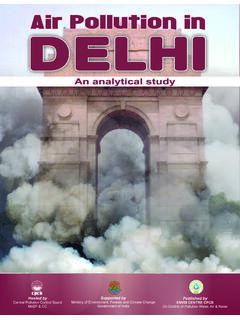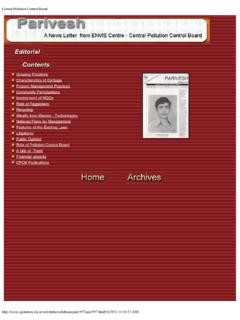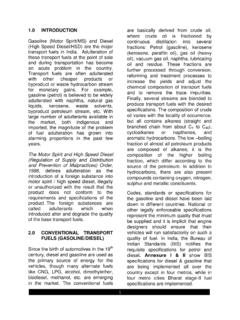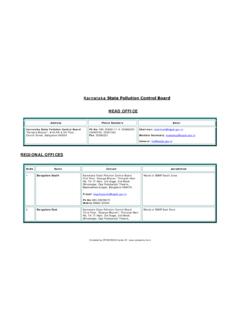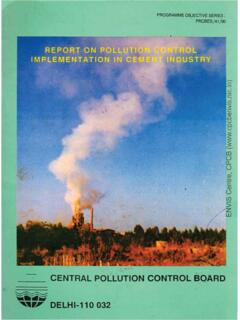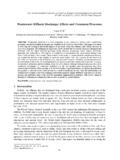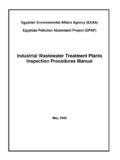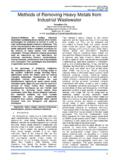Transcription of INTRODUCTION - CPCB ENVIS
1 1 Urban environmental management is one of the most pressing issues as the urbanization trend continues globally. Among the challenges faced by urban planners is the need to ensure ongoing basic human services such as the provision of water and sanitation. The under-management of domestic wastewater in many southern urban areas presents a major challenge. The accumulation of human waste is constant and unmanaged wastewater directly contributes to the contamination of locally available freshwater supplies. Additionally, the cumulative results of unmanaged wastewater can have broad degenerative effects on both public and ecosystem health.
2 INTRODUCTION India is rich in water resources, having a network of as many as 113 rivers (the figure does not include tributaries) and vast alluvial basins to hold plenty of groundwater. India is also blessed with snow-capped peaks in the Himalayan range, which can meet a variety of water requirements of the country. However, with the rapid increase in the population of the country and the need to meet the increasing demands of irrigation, domestic and industrial consumption, the available water resources in many parts of the country are getting depleted and the water quality has deteriorated. In India, water pollution comes from three main sources: domestic sewage, industrial effluents and run-off from agriculture.
3 The most significant environmental problem and threat to public health in both rural and urban India is inadequate access to clean drinking water and sanitation facilities. Almost all the surface water sources are contaminated to some extent by organic pollutants and bacterial contamination and make them unfit for human consumption unless disinfected. The diseases commonly caused by contaminated water are typhoid, cholera, gastroenteritis, bacterial dysentery, hepatitis, poliomycitis, amoebic dysentery etc. wastewater GENERATION & TREATMENT: DOMESTIC SEWAGE VS INDUSTRIAL EFFLUENT It is estimated that 22,900 million litres per day (MLD) of domestic wastewater is generated from urban centres against 13,500 MLD industrial wastewater .
4 The treatment capacity available for domestic wastewater is only for 5,900 MLD, against 8,000 MLD of industrial wastewater . Thus, there is a big gap in treatment of domestic wastewater . Govt. of India is assisting the local bodies to establish sewage treatment plants under the Ganga Action Plan and subsequently under the National River Action Plan. Since the task is massive, it may take long time to tackle the treatment of entire wastewater . It is estimated that the total cost for establishing treatment system for the entire domestic wastewater would be around Rs. 7,560 crores. Operation & maintenance cost would be in addition to this cost. Similarly, there is a gap in treatment of about 5,500 MLD of industrial wastewater , mainly generated from small-scale industries.
5 Establishing effluent treatment systems in small-scale industries is a problem, since a large number Domestic human waste includes human excreta, urine and the associated sludge (collectively known as black water), and wastewater generated through bathing and kitchen (collectively known as grey water). In 1950, the average daily output of human waste ( excrement and urine) was estimated to be million tonnes; in the year 2000, the estimated daily output was million tonnes. 2 of them are located in residential areas, where space is a constraint. Moreover, the small-scale industries are not having adequate resources to establish treatment systems.
6 Such industries need to establish common effluent treatment plants (CETPs). A number of such facilities have been established across the country. It is expected that establishment of CETPs would reduce the pollution load in the aquatic resources of the country to a large extent. URBANISATION & wastewater MANAGEMENT IN INDIA The process of urbanisation in India since the beginning of last century reveals a steady increase in the size of its urban population, number of urban centres, and level of urbanisation since 1911 onwards and a rapid rise after 1951. From a modest base of million persons in 1901, the number of urban dwellers has risen to 285 million, signalling a phenomenal eleven fold increase in urban population over the period 1901-2001.
7 The urban India has become a massive and perhaps a frightening reality as far as waste management is concerned. This country can no longer afford to allow urban areas constituting cities and towns of varying magnitude to take care of them; they need the full and undivided attention of our planners and decision makers for protection of environment, aquatic resources and ultimately for better management of health aspects. The Central Pollution Control Board realised the gravity of water quality deterioration in water bodies and instituted studies on the wastewater management in India with changing urban pattern during last three decades and highlighted the need for urban wastewater management.
8 The comparison of water supply, wastewater generation, collection and treatment during 1978-79, 1989-90 and 1994-95 indicates that the wastewater generation has increased from 7,007mld in 1978-79 to 16,622 mld in 1994-95 in class I cities (population one lakh or above). However, the treatment capacity has Comparision of pollution load generation from Domestic and Industrial Sources134689478177622900458035100500010 000150002000025000 wastewater gen (mld)BOD Generation (t/d)BOD Discharge (t/d)IndustrialDomestic 3 increased from mld in 1978-79 to mld in 1994-95, which was only 39% and 24% of the wastewater generated respectively. Decadal Trend of water supply and sanitation status in Class I Cities and Class II towns Parameters Class I cities Class II Towns 1978-79 1989-90 1994-95 1978-79 1989-90 1994-95 Number 142 212 299 190 241 345 Population (millions) 60 102 128 Water Supply (mld) 8,638 15,191 20,607 1533 1622 1936 wastewater generated (mld) 7,007 12,145 16,662 1226 1280 1650 wastewater treated (mld) 2,756 (39%) 2,485 ( ) 4,037 (24%) 67 ( ) 27 ( ) 62 ( ) wastewater untreated (mld) 4,251 (61% 9,660 ( ) 12,625 (76%) 1160 ( ) 1252 ( ) 1588 ( ) As per the updated status for the year 2003, out of 22,900 Mld of wastewater generated, only about 5,900 Mld (26%))
9 Is treated before letting out, the rest , 17,100 Mld is disposed of untreated. Twenty-seven cities have only primary treatment facilities and forty-nine have primary and secondary treatment facilities. The level of treatment available in cities with existing treatment plant in terms of sewage being treated varies from to 89% of the sewage generated. Treated or partly treated or untreated wastewater is disposed into natural drains joining rivers or lakes or used on land for irrigation/ fodder cultivation or disposed into the sea or a combination of them by the municipalities. The mode of disposal in 118 cities is indirectly but ultimately into the rivers/ lakes/ ponds/ creeks; in 63 cities to the agriculture land; in 41 cities directly into rivers and in 44 cities, it is discharged both into rivers and on agriculture land.
10 Status of Sewage Treatment in the Ganga Basin The Ganga basin spreads over an area of 8,61,404 Km2 covering the States of Uttaranchal, Uttar Pardesh, Haryana, Delhi, Madhya Pradesh, Rajasthan, Bihar, Jharkhand & West Bengal. There are 223 cities/towns (Municipalities/ Corporations) generating significant amount of sewage in the Ganga basin. These cities/towns generate about 8,250 MLD (million litre per day) of wastewater , out of which about 2,460 MLD is directly discharged into the Ganga river, about 4,570 MLD is discharged into its tributaries or sub- tributaries and about 1220 MLD is disposed on land or on low- lying areas. Out of 8,250 MLD wastewater generated in the Ganga basin, the treatment facilities available for 3,500 MLD of wastewater .
